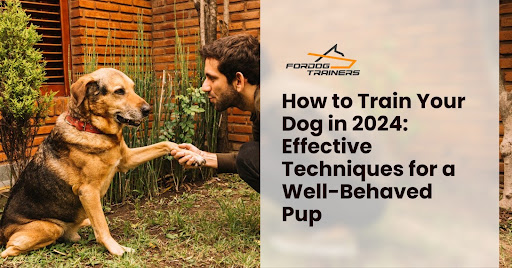As we move into 2024, dog training has evolved to include a variety of techniques and tools that can help you cultivate a well-behaved, happy, and healthy dog. Whether you’re a first-time dog owner or a seasoned pro, staying up-to-date on the latest training methods can make a world of difference in your relationship with your furry friend. In this comprehensive guide, we’ll explore the most effective dog training techniques for 2024.
Understanding Your Dog’s Learning Style
Before diving into specific training techniques, it’s crucial to understand how dogs learn. Dogs are primarily motivated by two things: avoiding discomfort and seeking rewards. As a trainer, your job is to make the desired behavior as rewarding as possible while minimizing the rewards for unwanted behaviors.
Dogs also learn through association. If a particular behavior consistently results in a positive outcome (like getting a treat or praise), they’re more likely to repeat that behavior. Conversely, if a behavior leads to an unpleasant consequence (like being ignored or losing access to a toy), they’re less likely to do it again.
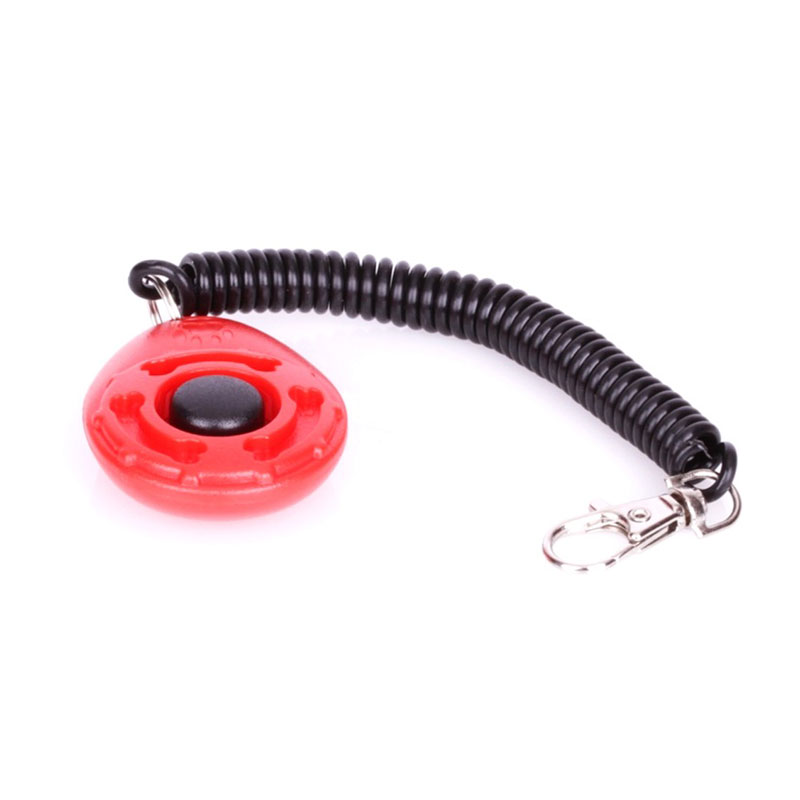
Clicker training is a popular method that uses these principles. The clicker allows you to mark the exact moment your dog does the desired behavior, and the click is always followed by a reward. Over time, your dog learns that the click means they’ve done something right, and the behavior becomes more frequent.
Basic Obedience Training
Obedience training is the foundation of a well-behaved dog. It teaches your dog to respond to basic commands like sit, stay, come, and heel. Consistency is key when teaching these commands. Use the same words each time, and always reward your dog for complying.
Teaching “Sit”
- Hold a treat close to your dog’s nose.
- Move your hand up, allowing their head to follow the treat and causing their bottom to lower.
- Once they’re in sitting position, say “Sit,” give them the treat, and share affection.
Repeat this sequence a few times every day until your dog has it mastered. Then ask your dog to sit before mealtime, when leaving for walks, and during other situations where you’d like them calm and seated.
Teaching “Stay”
- Ask your dog to “Sit.”
- Open the palm of your hand in front of you, and say “Stay.”
- Take a few steps back. Reward them with a treat and affection if they stay.
- Gradually increase the number of steps you take before giving the treat.
- Always reward your dog for staying put — even if it’s just for a few seconds.
This is an exercise in self-control for your dog, so don’t be discouraged if it takes a while to master, particularly for puppies and high-energy dogs. After all, they want to be on the move and not just sitting there waiting.
Teaching “Come”
- Put a leash and collar on your dog.
- Go down to their level and say, “Come,” while gently pulling on the leash.
- When they get to you, reward them with affection and a treat.
- Once they’ve mastered it with the leash, remove it — and practice the command in a safe, enclosed area.
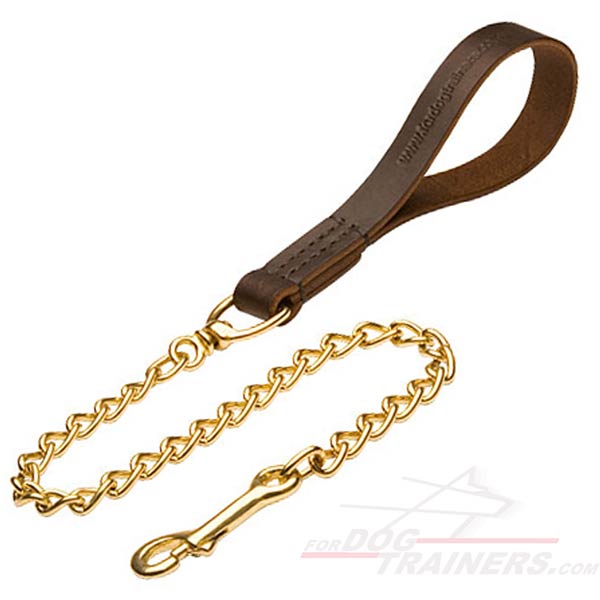
A quality leash is essential for training the “Come” command. For Dog Trainers offers a variety of durable leashes, like this one with a comfortable leather handle and strong chain.
Leash Training
Leash training is another essential aspect of dog training. It teaches your dog to walk calmly by your side without pulling or lunging. Start in a quiet, distraction-free area, and gradually build up to busier environments.
Start by letting your dog get used to wearing a collar or harness and a leash. Let them wear it around the house for short periods, giving them treats and praise.
Once they’re comfortable, pick up the leash and walk around the house with your dog following you. If they start to pull, stop walking and wait for them to come back to you.
When they’re walking calmly by your side, reward them with treats and praise.
Gradually increase the duration of your walks and start to introduce distractions. If your dog starts to pull, stop walking and wait for them to return to your side.
Shop Dog Collars at For Dog Trainers
Shop Dog Harnesses at For Dog Trainers
Choosing the right collar or harness is crucial for successful leash training. For Dog Trainers has a wide selection of collars and harnesses for every breed and need.
Crate Training
Crate training can be a valuable tool in housetraining your dog and providing them with a safe, comfortable space of their own. However, it’s important to introduce the crate gradually and to never use it as a punishment.
Start by making the crate inviting. Put a soft blanket or bed inside, and leave the door open.
Encourage your dog to enter the crate by throwing treats inside. When they go in, praise them.
Begin feeding your dog their meals inside the crate. This creates a positive association.
Once your dog is comfortable entering the crate, start closing the door for short periods while you’re home.
Gradually increase the amount of time your dog spends in the crate, and start leaving them crated for short periods when you leave the house.
Shop Kennel Accessories at For Dog Trainers
For Dog Trainers offers a variety of kennel accessories to make your dog’s crate a comfortable and inviting space.
Potty Training
Potty training is a crucial part of dog ownership. The key to success is consistency, patience, and plenty of positive reinforcement.
Establish a routine. Take your dog out first thing in the morning, after meals, after naps, and before bedtime.
Choose a bathroom spot outside, and always take your dog to that spot. Use a specific word or phrase that you can eventually use to remind them what to do.
Reward your dog every time they eliminate outdoors.
Supervise your dog indoors and watch for signs that they need to go out (sniffing, circling, restlessness).
If you catch your dog in the act of having an accident, interrupt them with a startling noise and immediately take them outside.
Clean up accidents with an enzymatic cleaner designed to neutralize odors.
Remember, accidents are part of the process. Never punish your dog for going inside. This will only make them fearful of going to the bathroom in your presence.
Dealing with Problem Behaviors
Even with the best training, dogs can develop problem behaviors. Here are some common issues and how to deal with them:
Barking
Barking is a natural behavior for dogs, but excessive barking can be a problem. First, try to identify what’s causing your dog to bark. Are they bored? Anxious? Seeking attention? Once you know the cause, you can work on solving the problem.
For example, if your dog barks when they’re left alone, they may be experiencing separation anxiety. Crate training and gradually increasing the amount of time they spend alone can help. You might also consider leaving them with a puzzle toy to keep them occupied.
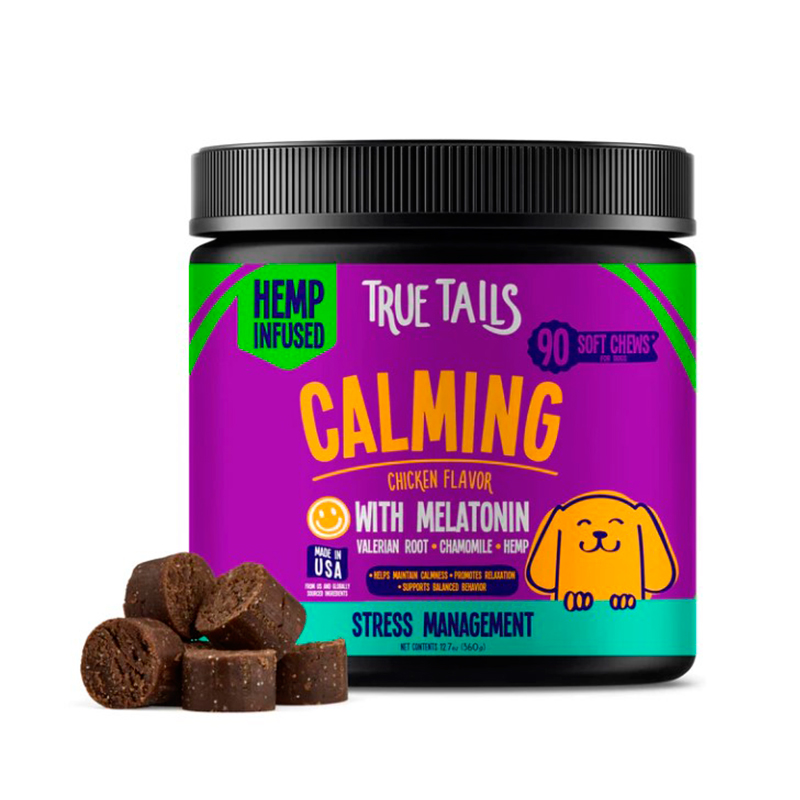
Calming treats can also be helpful for dogs prone to anxious barking. For Dog Trainers offers these calming support treats with hemp for dogs.
Chewing
Chewing is another natural dog behavior, but it can be destructive when directed at your shoes or furniture. The best way to deal with chewing is to redirect your dog’s attention to appropriate chew toys.
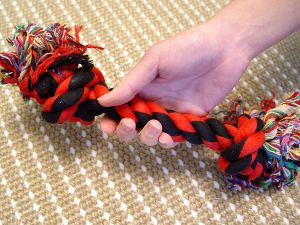
Provide a variety of chew toys, and rotate them to keep things interesting. This fiber bone from For Dog Trainers is a great option — it helps keep teeth clean and is machine washable.
Jumping
Jumping up on people is a common behavior in dogs, especially when they’re excited. While it might be cute when they’re puppies, it can become problematic as they grow larger.
The best way to prevent jumping is to ignore the behavior. When your dog jumps up, turn your back and don’t engage. Once they settle down, give them attention and praise. You can also teach an alternate behavior, like sitting, and reward that instead.
Advanced Training Techniques
Once your dog has mastered the basics, you might consider moving on to more advanced training. This can include things like agility training, trick training, or even service dog training.
Agility Training
Agility training involves teaching your dog to navigate an obstacle course, usually under the guidance of your commands. It’s a great way to provide mental and physical stimulation for your dog.
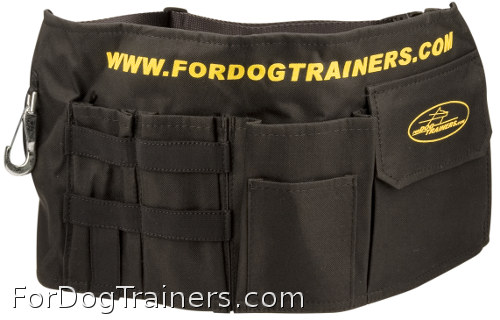
To get started, you’ll need some basic agility equipment, like jumps, tunnels, and weave poles. You’ll also need plenty of treats to reward your dog as they learn. A treat pouch like this one from For Dog Trainers can be very handy.
Trick Training
Teaching your dog tricks is not only fun, but it also provides mental stimulation and strengthens your bond. Start with simple tricks like “shake” or “roll over,” and gradually work up to more complex ones.
Shop Dog Treats at For Dog Trainers
As with all training, use plenty of treats and positive reinforcement. For Dog Trainers offers a variety of healthy treat options.
Service Dog Training
Service dogs are specially trained to assist people with disabilities. Training a service dog is a serious undertaking that requires dedication and specialized knowledge.
If you think your dog might have the temperament to be a service dog, the first step is to have them evaluated by a professional service dog organization. They can guide you through the training process.
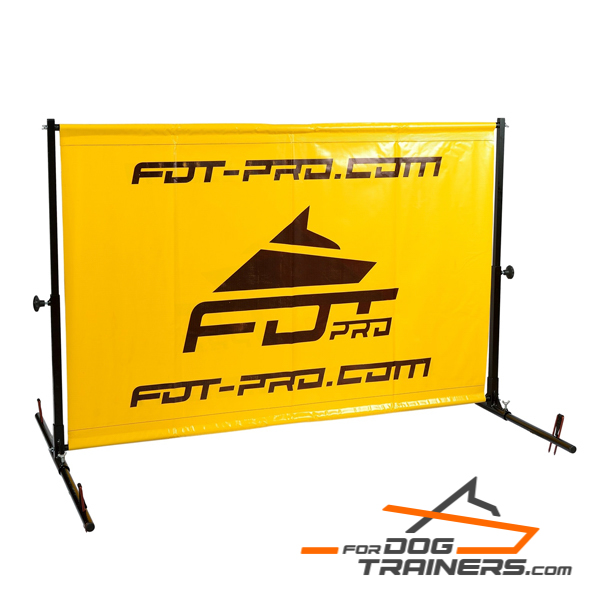
Many service dog organizations use Schutzhund training techniques, which originated as a test for German Shepherds. This Schutzhund training jump from For Dog Trainers can be a useful tool.
The Importance of Socialization
Socialization is the process of exposing your dog to a variety of people, animals, places, and experiences. It’s crucial for helping your dog develop into a well-adjusted, confident adult.
The prime socialization period for puppies is between 3 and 16 weeks of age. During this time, it’s important to expose your puppy to as many new experiences as possible in a positive way.
This can include:
- Meeting people of different ages, races, and genders
- Exposure to other dogs and animals
- Experiencing different surfaces (grass, concrete, carpet, etc.)
- Exposure to various sounds (traffic, fireworks, household appliances, etc.)
- Visiting different places (the park, the beach, the pet store, etc.)
It’s important to let your puppy progress at their own pace. Don’t force them into situations where they’re uncomfortable. Use treats and praise to create positive associations.
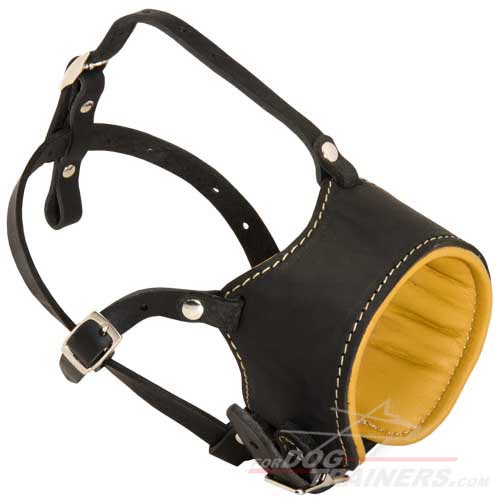
For some puppies, a muzzle can be a useful tool for safe socialization. It allows them to interact with the world without the risk of nipping or biting out of fear or overexcitement. This soft leather muzzle from For Dog Trainers is a comfortable option.
Using Positive Reinforcement
Positive reinforcement is the most effective and humane way to train your dog. It involves rewarding the behaviors you want to see more of, which makes your dog more likely to repeat those behaviors in the future.
Rewards can include treats, praise, toys, or anything else your dog finds valuable. The key is to time the reward correctly. The reward must occur immediately after the desired behavior for your dog to make the association.
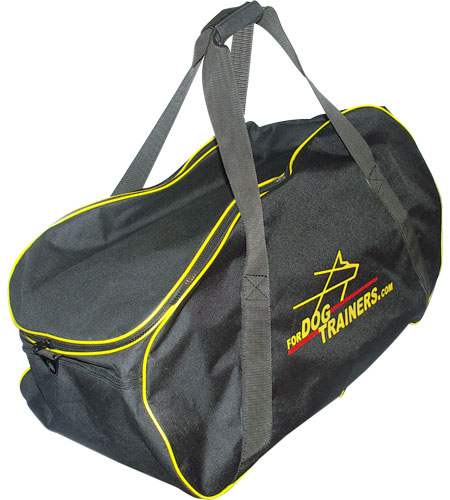
When training with treats, it’s helpful to have a treat bag that you can wear around your waist for easy access. This ultimate dog training bag from For Dog Trainers has plenty of room for treats, toys, and other training essentials.
Avoiding Punishment
While it might be tempting to punish your dog for unwanted behaviors, this is usually counterproductive. Punishment can lead to fear, anxiety, and aggression, and it doesn’t teach your dog what you want them to do instead.
Instead of punishing unwanted behaviors, focus on rewarding the behaviors you do want. For example, if your dog jumps up on people, teach them to sit instead, and reward them for sitting.
If you do need to interrupt an unwanted behavior, use a neutral interrupter like “oops” or “no reward.” Then immediately redirect your dog to a more appropriate behavior.
Finding a Professional Trainer
While many dog owners successfully train their dogs on their own, sometimes it’s helpful to enlist the help of a professional. This is especially true if you’re dealing with more serious behavior issues.
When looking for a trainer, seek out someone who uses positive reinforcement methods. Avoid anyone who advocates for dominance-based training or punishment.
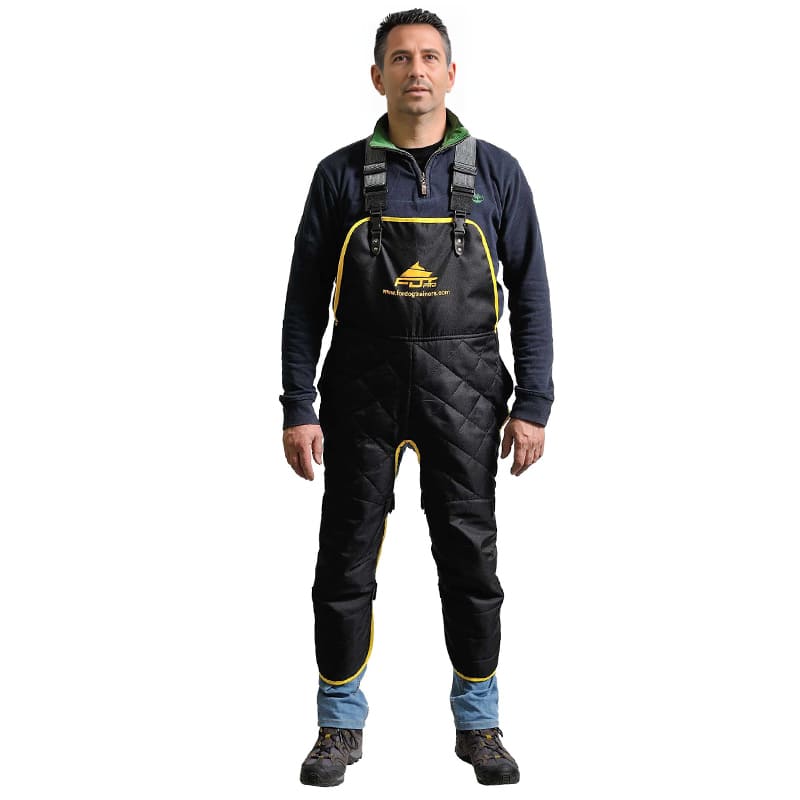
Many professional trainers wear specialized clothing to keep their training gear organized and accessible. This free-motion training apron from For Dog Trainers is a popular choice.
Continuing Education
Dog training isn’t a one-and-done process. It’s important to continue reinforcing your dog’s training throughout their life.
Set aside time each day for short training sessions. This can be as simple as a quick 5-minute refresher of basic commands, or a more involved session working on new skills. The key is to keep it fun and engaging for both you and your dog.
It’s also important to continue socializing your dog throughout their life. This can include regular visits to the dog park, doggy daycare, or arranging playdates with other friendly dogs.
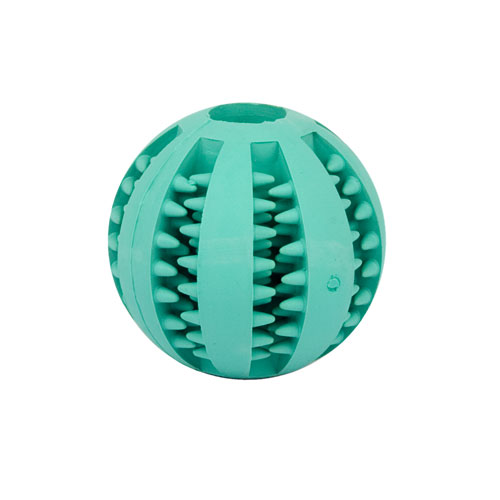
Continuing education isn’t just for your dog — it’s for you, too! Keep yourself informed about the latest training techniques and tools. Attend workshops, read books, or watch training videos to continually improve your skills. And don’t forget about your dog’s physical and mental health. Regular exercise, mental stimulation, and dental hygiene (like using this dental hygiene ball from For Dog Trainers) are all part of being a responsible dog owner.
The Benefits of a Well-Trained Dog
Training your dog takes time, patience, and consistency, but the benefits are well worth the effort. A well-trained dog is a joy to live with. They can accompany you to more places, participate in more activities, and are less likely to develop behavior problems.
Training also strengthens the bond between you and your dog. It builds trust, enhances communication, and makes your relationship more rewarding for both of you.

Plus, a well-trained dog is a fashionable dog! With the wide variety of collars, leashes, and other accessories available from For Dog Trainers, you can show off your dog’s skills in style. Check out this amazing set of six wide leather dog collars.
Conclusion
Training your dog is an ongoing process that requires dedication, patience, and a commitment to positive, reward-based methods. By staying informed about the latest techniques, using the right tools, and continually reinforcing your dog’s skills, you can help your furry friend become a well-behaved, well-adjusted member of your family.
Remember, every dog is unique, and what works for one may not work for another. Be patient, be consistent, and most of all, enjoy the journey with your four-legged friend.
Visit For Dog Trainers for All Your Dog Training Needs
Whether you’re just starting out or you’re a seasoned pro, For Dog Trainers has everything you need to make your dog training journey a success. From collars and leashes to training aids and treats, we’ve got you covered. Start browsing our collection today and take the first step towards a better-behaved dog in 2024 and beyond!

